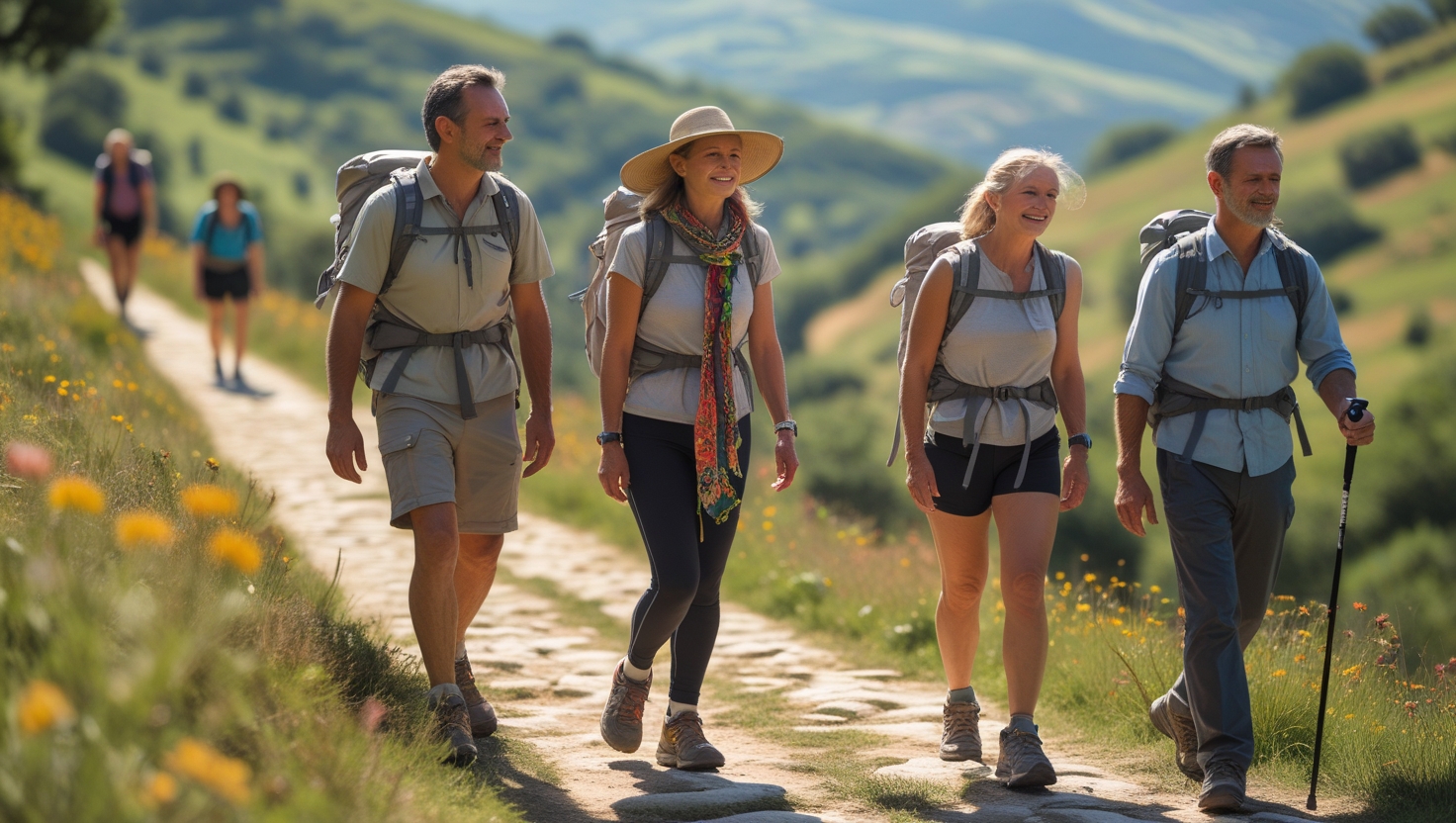Most people see ageing as an inevitable march forward. They’ve accepted the conventional wisdom that our bodies and minds will deteriorate with each passing year. I used to believe this too.
Until I didn’t.
What if I told you that the biological clock inside your cells can actually run backwards? That the ageing process—once thought to be as unstoppable as gravity—is increasingly looking like something we can manipulate, slow, and in some cases, partially reverse?
This isn’t science fiction. It’s an emerging scientific fact. And it’s happening right now.
The Wake-Up Call That Changed Everything
One of my retreat guests recently told me that three years ago, she found herself staring at lab results that shocked her to her core. Despite her “healthy” diet and moderate exercise routine, her biological markers resembled those of someone nearly two decades older than her chronological age. Two decades! Her inflammation levels were through the roof. Her telomeres—those protective caps on our chromosomes that shrink as we age—were much shorter than they should have been. Her mitochondria—the powerhouses in our cells—were functioning at about 60% of optimal capacity.
In short, she was ageing fast. Too fast.
That made me think. I suspected the same was true for me. Intermittent fasting has been part of my life for nearly 7 years, but there is much more that one can do, as you’ll find out in this article. You can continue down the path of passive ageing—accepting the mainstream narrative that deterioration is inevitable—or you can dive deep into the emerging science of longevity and take radical ownership of your biological destiny.
I chose the latter. What I discovered changed everything I thought I knew about the human lifespan.
Across the globe, a quiet revolution is happening as researchers, physicians, and everyday biohackers are dismantling our most fundamental assumptions about ageing.
The Fundamental Shift: From Treating Disease to Targeting Ageing
For centuries, medicine has focused on treating diseases once they emerge. See a symptom, diagnose the condition, and prescribe a treatment. This reactive approach has certainly extended our average lifespans—but it’s done little to extend our healthspans, the period during which we remain vibrant and disease-free.
The longevity revolution flips this paradigm on its head. Instead of waiting for age-related diseases to manifest, we’re now targeting the underlying mechanisms of ageing itself.
Think about it: heart disease, cancer, diabetes, Alzheimer’s—these aren’t isolated conditions that randomly strike some unlucky individuals. They’re largely manifestations of cellular and metabolic dysfunction that accumulate over time. They are, in essence, symptoms of ageing.
By addressing the root causes of biological ageing directly, we can potentially prevent or delay the onset of these conditions altogether. This represents perhaps the most significant shift in healthcare philosophy since the discovery of antibiotics.
Truth vs. Myth: Separating Longevity Science from Snake Oil
Before diving into practical strategies, let’s clear away some of the confusion that permeates this field. The science of longevity attracts both breakthrough research and questionable marketing claims. Let’s separate fact from fiction:
MYTH: Ageing is programmed into our genes and cannot be altered.
TRUTH: While genetics play a role, they account for only about 20-30% of how we age. The rest comes down to lifestyle, environment, and interventions that can significantly alter your aging trajectory. Twin studies have shown dramatic differences in ageing rates based on lifestyle factors alone.
MYTH: Anti-ageing interventions merely mask the appearance of ageing.
TRUTH: Many evidence-based interventions affect ageing at the cellular and molecular level, not just superficially. Techniques like intermittent fasting and certain exercise protocols have been shown to trigger autophagy (cellular cleanup), improve mitochondrial function, and positively influence epigenetic markers.
MYTH: Longevity science is only about living longer.
TRUTH: The field is primarily focused on extending healthspan—the period of life spent in good health, free from chronic disease and disability. A longer lifespan is often a byproduct of a longer healthspan, not the primary goal.
MYTH: Effective anti-ageing interventions are only available to the wealthy elite.
TRUTH: While some cutting-edge therapies remain expensive, many of the most powerful longevity practices cost nothing or very little: specific forms of fasting, optimised sleep, cold exposure, and strategic exercise protocols all deliver significant benefits without breaking the bank.
MYTH: It’s too late to start once you’re past a certain age.
TRUTH: Research consistently shows that positive biological changes can occur at any age. Studies of 80+ year-olds show remarkable adaptability and improvement with appropriate interventions. The human body maintains impressive regenerative capacity throughout life.
The Biology of Ageing: Understanding the Mechanisms We Can Influence
To effectively hack the ageing process, we need to understand what’s actually happening in our bodies over time. Researchers have identified several hallmarks of ageing that contribute to deterioration, and remarkably, we now have interventions that can target each one.
1. Cellular Senescence
As we age, some cells enter a zombie-like state called senescence. They stop dividing but refuse to die, secreting inflammatory compounds that damage surrounding tissues. These senescent cells accumulate over time, driving systemic inflammation and age-related disease.
Biohack Opportunity: Fasting protocols, certain exercise regimens, and compounds like quercetin and fisetin have shown promise in clearing senescent cells, potentially restoring tissue function.
2. Mitochondrial Dysfunction
Our cellular power plants—mitochondria—become less efficient with age, producing less energy and more harmful free radicals. This energy crisis affects every system in our bodies, from muscular strength to cognitive function.
Biohack Opportunity: Mitochondrial biogenesis (the creation of new mitochondria) can be stimulated through high-intensity interval training, cold exposure, and compounds like PQQ and CoQ10.
3. Telomere Attrition
Each time our cells divide, the protective caps on our chromosomes—telomeres—get slightly shorter. When telomeres become critically short, cells either die or become senescent, accelerating ageing.
Biohack Opportunity: Telomerase activators like TA-65 remain controversial, but stress reduction, meditation, and certain dietary patterns have shown associations with preserved telomere length.
4. Declining Proteostasis
As we age, our cells become less efficient at maintaining proper protein balance—creating, folding, and recycling proteins correctly. This leads to protein aggregation implicated in neurodegenerative diseases.
Biohack Opportunity: Practices that induce autophagy (cellular cleanup), like intermittent fasting and certain exercise protocols, can help restore proper protein balance.
6. Nutrient Sensing Dysfunction
Ageing cells lose their ability to accurately detect and respond to nutrient levels, leading to metabolic disorders and accelerated ageing.
Biohack Opportunity: Strategic caloric restriction and intermittent fasting can help restore proper nutrient sensing, particularly through pathways like mTOR and AMPK.
7. Stem Cell Exhaustion
Our reservoirs of regenerative stem cells decline with age, reducing our capacity to repair tissues and recover from injury.
Biohack Opportunity: Certain peptides, exercise protocols, and nutritional interventions may help preserve stem cell function and stimulate their activation.
8. Chronic Inflammation
Perhaps the most actionable hallmark of aging is “inflammaging”—the persistent low-grade inflammation that increases with age and drives countless age-related diseases.
Biohack Opportunity: Anti-inflammatory dietary patterns, strategic supplementation, gut health optimisation, and stress management can significantly reduce systemic inflammation.
The Big Five: Foundational Longevity Strategies
While the field of longevity science continues to advance rapidly, four interventions consistently demonstrate the most profound impacts on biological ageing. Master these fundamentals before exploring more experimental approaches.
1. Strategic Eating Windows
The timing of when you eat may be even more important than what you eat. Research on time-restricted eating (typically 16:8 or 18:6 patterns, where you consume all calories within a 6-8 hour window) shows remarkable benefits for metabolic health, cellular cleanup (autophagy), inflammation reduction, and longevity pathways.
More extreme protocols like 5:2 fasting or quarterly 3-5 day fasting mimicking diets have shown even more pronounced effects on aging biomarkers, though they require more careful implementation.
The key insight here isn’t about caloric deprivation—it’s about giving your body regular periods without the metabolic burden of processing nutrients, allowing cellular repair mechanisms to activate fully.
2. Hormetic Stress
Hormesis refers to beneficial adaptations that occur when we expose ourselves to certain stressors in controlled doses. Three forms of hormetic stress have shown particularly powerful anti-ageing effects:
Cold Exposure: Regular cold showers, ice baths, or cryotherapy sessions trigger profound adaptations in mitochondrial function, inflammation reduction, and metabolic health. Start with 30 seconds of cold water at the end of your shower and gradually build tolerance.
Heat Exposure: Regular sauna sessions (ideally 20+ minutes at 170-200°F, 4+ times weekly) have been associated with remarkable reductions in all-cause mortality, cardiovascular disease, and neurodegenerative conditions. The physiological stress of heat triggers protective adaptations throughout the body.
Exercise Hormesis: Strategic exercise—particularly high-intensity interval training (HIIT) and zone 2 cardio (moderate intensity where you can still talk)—creates beneficial metabolic adaptations that directly counter ageing processes. The key is appropriate recovery between stressors.
3. Sleep Optimisation
Sleep isn’t just rest—it’s an active biological process essential for cellular repair, brain maintenance, and metabolic health. Poor sleep accelerates virtually every hallmark of ageing.
Beyond quantity (7-9 hours for most adults), quality and timing matter tremendously. Deep sleep stages drive physical restoration, while REM sleep consolidates learning and emotional processing. Both decline with age unless actively protected.
Strategic sleep hygiene—consistent sleep/wake times, temperature-controlled bedrooms (65-68°F), light management (blue light blocking in evenings, morning sunlight exposure), and sleep tracking—can add years to your healthspan with minimal financial investment.
4. Metabolic Flexibility
Your body’s ability to efficiently switch between different fuel sources—primarily glucose and ketones—appears central to longevity. Most modern humans are stuck in glucose-burning mode due to constant eating and high-carbohydrate diets.
Developing metabolic flexibility through strategic carbohydrate manipulation, intermittent fasting, and targeted physical activity enables more efficient energy production, reduced oxidative stress, and enhanced cellular cleanup mechanisms.
While full ketogenic diets show mixed results in longevity research, the ability to occasionally tap into ketosis appears beneficial for most people.
5. Nature Immersion: The Overlooked Longevity Elixir
Before diving into the big four, I need to highlight what might be the most underappreciated longevity intervention of all: time spent in natural environments. The research on this is nothing short of remarkable.
Regular immersion in natural settings—forests, beaches, mountains, even urban parks—triggers profound physiological changes that directly counter the ageing process. Just 120 minutes per week in nature (whether as one long session or multiple shorter visits) has been associated with significantly better health and wellbeing.
The mechanisms are fascinatingly diverse: Forest environments contain phytoncides—antimicrobial volatile compounds released by trees—that boost our natural killer cell activity for weeks after exposure. These immune cells play crucial roles in eliminating senescent cells and fighting age-related disease.
The fractal patterns found throughout nature—in tree branches, river systems, and leaf structures—induce a state called “soft fascination” that allows the prefrontal cortex to recover from attention fatigue while reducing stress hormones like cortisol. Chronic elevation of these hormones accelerates virtually every aspect of ageing.
Soil bacteria like Mycobacterium vaccae, inhaled during nature walks, appear to stimulate serotonin production and reduce inflammation through interactions with our immune system. Even the negative ions abundant near moving water and in forests have been shown to reduce inflammation and oxidative stress.
Perhaps most compelling is the effect on our circadian biology. Morning sunlight exposure in natural settings helps synchronise our master biological clock, improving sleep quality, hormone regulation, and cellular repair mechanisms that decline with age.
The beauty of this intervention is its simplicity and accessibility. You don’t need expensive equipment or complex protocols—just the commitment to regularly step away from artificial environments and reconnect with the natural world that shaped our biology for millions of years.
Five Key Takeaways for Your Longevity Quest
- Ageing is flexible, not fixed. Your biological age can diverge significantly from your chronological age through targeted interventions. Regular biomarker testing can help track your progress and personalise your approach.
- Consistency in fundamentals outperforms perfectionism. Imperfect but consistent practice of time-restricted eating, quality sleep, hormetic stress, and metabolic health will deliver better results than occasional perfect days followed by complete abandonment.
- The dose makes the medicine. Both too little and too much of any intervention can be counterproductive. Start conservatively, track your responses, and gradually increase intensity as your body adapts.
- Personalisation is essential. Genetic variations, gut microbiome differences, and personal health history all influence which interventions will work best for you. Consider working with a longevity-focused healthcare provider to develop your personalised protocol.
- Mental models matter as much as methods. Approach ageing not as something to fear or fight, but as a biological process you can influence. Cultivate purpose, meaningful relationships, and stress resilience alongside physical interventions—psychological well-being profoundly affects biological ageing.
The Future Is Already Here
We stand at a remarkable inflexion point in human history. For the first time, we’re developing the tools and knowledge to potentially extend healthy human lifespan well beyond current limitations. The scientists leading this field—David Sinclair, Valter Longo, Rhonda Patrick, Peter Attia—increasingly suggest that the first humans who might live to 120+ with good health and vitality are already among us.
Whether or not that extreme proves achievable, the evidence is clear: we can significantly influence how we age starting today, using approaches that are increasingly well-supported by rigorous science.
The goal isn’t merely more years of life, but more life in our years—maintaining physical capacity, cognitive function, and zest for living throughout our entire lifespan.
Where Do You Go From Here?
If you’re intrigued by the possibility of extending your healthspan and potentially your lifespan through evidence-based approaches, I invite you to attend one of my Trail Tracers Camino de Santiago retreats.
Most guests arrive carrying stress, burnout, indecision, or a quiet grief they haven’t had space to acknowledge.
They leave feeling younger—not just emotionally, but physically. Their posture changes. Their faces soften. They smile more easily. The sparkle returns to their eyes.
They return home not just rested, but reset—mentally, emotionally, and spiritually. With renewed clarity, restored energy, and a sense of possibility that had gone missing in the chaos of everyday life.
Click here to find out more.

10 Powerful Life Lessons Learned While Walking the Camino de Santiago – a free guide filled with 10 not just “quaint anecdotes” or Instagram-worthy moments (though there are plenty of those) but real transformations from real people who walked the same insight-giving trail you might want to walk one day – Subscribe to my monthly newsletter to Download the Guide
Hit the pause button and regain your footing during a From Troubled to Triumphant Retreat. Imagine walking a peaceful stretch of the Camino de Santiago, where every step helps untangle the mental clutter or spending time with gentle Friesian horses who teach you the art of mindfulness. Whether you choose to make a change or are forced to, this retreat offers the perfect blend of peace, perspective, and playful exploration to help you rise from troubled to triumphant!


“I am an experienced medical doctor – MBChB, MRCGP, NLP master pract cert, Transformational Life Coach (dip.) Life Story Coach (cert.) Stress Counselling (cert.) Med Hypnotherapy (dip.) and EAGALA (cert.) I may have an impressive number of letters after my name, and more than three decades of professional experience, but what qualifies me to excel at what I do is my intuitive understanding of my clients’ difficulties and my extensive personal experience of managing major life changes using strategies I developed over many years.” Dr M Montagu















